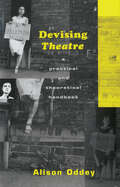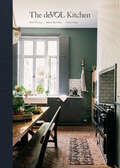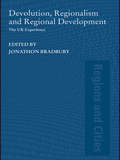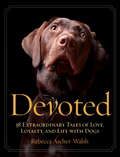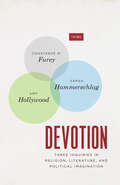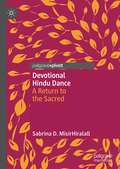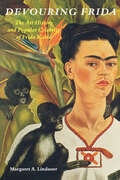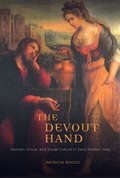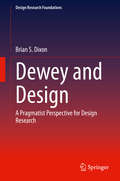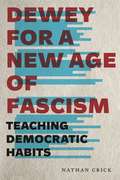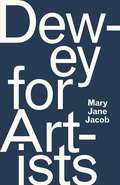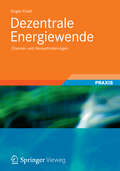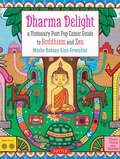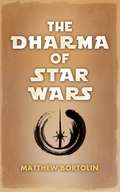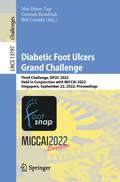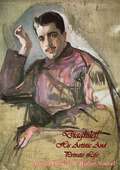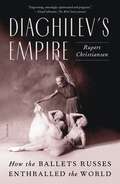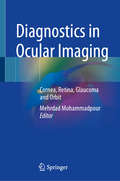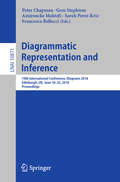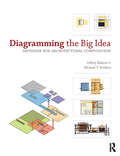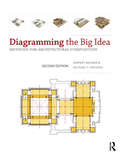- Table View
- List View
Devising Theatre: A Practical and Theoretical Handbook
by Alison OddeyDevising Theatre is a practical handbook that combines a critical analysis of contemporary devised theatre practice with descriptions of selected companies, and suggestions for any group devising theatre from scratch. It is the first book to propose a general theory of devised theatre. After identifying the unique nature of this type of performance, the author examines how devised theatre is perceived by professional practitioners, and provides an historical overview illustrating how it has evolved since the 1960s. Alison Oddey examines the particular working practices and products of a number of professional companies, including a Reminiscence theatre for the elderly and a theatre-in-education group, and offers ideas and exercises for exploration and experimentation.
The deVOL Kitchen: Designing and Styling the Most Important Room in Your Home
by Paul O'Leary Robin McLellan Helen ParkerA stunningly photographed guide to designing and styling your kitchen, the most used and important room in the home, that showcases the philosophy and fundamentals of deVOL&’s iconic values&“When it comes to thoughtful craftsmanship and bespoke kitchen design, deVOL is the benchmark.&” – Joanna GainesdeVOL is much more than a kitchen company. Paul O&’Leary, deVOL&’s founder, began his journey in a small workshop in Leicestershire, England, more than thirty years ago. Since that day, deVOL has grown into something special, inspiring many people with its unique approach to designing and styling the most important room in the home. Written by deVOL&’s directors, Paul O&’Leary, Robin McLellan and Helen Parker, The deVOL Kitchen is about far more than kitchens. It has stories about their personal journeys, and it is full of passion, determination, and sometimes a little luck. Alongside the inspiring photographs of kitchens they&’ve designed and furnished, The deVOL Kitchen reveals childhood memories and fascinating experiences that have undoubtedly shaped their unique approach to designing, making, and running deVOL. From total rebuilds to a more modest sink and cupboard upgrade, The deVOL Kitchen will inspire you to design and style the space available to create a unique and stylish kitchen, whatever your budget. It encourages you to throw out the conventional rule book, draw your own plans, and incorporate fitted and existing free-standing furniture and found objects to create a beautiful room that is perfect for your needs. The book&’s charming photography takes you on a journey, not only of gorgeous kitchens but also into the workshops, studios, and showrooms of deVOL. See craftspeople at work, close-up images of forging metal and throwing clay and how these skills are used to make all of deVOL&’s accessories, many of which are as desired as their kitchens.
Devolution, Regionalism and Regional Development: The UK Experience (Regions and Cities)
by Jonathan BradburyDevolution, Regionalism and Regional Development provides an overview and critical perspective on the impact of devolution on regionalism in the UK since 1999, taking a research-based look at issues central to the development of regionalism: politics, governance and planning. This multidisciplinary book is written by academics from the fields of geography, economics, town planning, public policy, management, public administration, politics and sociology with a final chapter by Patrick Le Gales putting the research findings into a theoretical context. This will be an important book for those researching and studying economic and political geography and planning as well as those involved in regional development.
Devoted
by Rebecca Ascher-WalshUnlikely Friendships meets Marley and Me. In this heartwarming gift book, author Rebecca Ascher-Walsh presents a collection of inspiring dog stories and touching photos--dogs who comfort veterans, dogs who learn to surf, dogs who detect cancer, and dogs who save the day: Each one is devoted. These 38 uplifting dog stories showcase the most amazing dog rescues, accomplishments, and abilities that fascinate us and touch our hearts.From the Hardcover edition.
Devotion: Three Inquiries in Religion, Literature, and Political Imagination (TRIOS)
by Constance M. Furey Sarah Hammerschlag Amy HollywoodThree scholars of religion explore literature and the literary as sites of critical transformation. We are living in a time of radical uncertainty, faced with serious political, ecological, economic, epidemiological, and social problems. Scholars of religion Constance M. Furey, Sarah Hammerschlag, and Amy Hollywood come together in this volume with a shared conviction that what and how we read opens new ways of imagining our political futures and our lives. Each essay in this book suggests different ways to characterize the object of devotion and the stance of the devout subject before it. Furey writes about devotion in terms of vivification, energy, and artifice; Hammerschlag in terms of commentary, mimicry, and fetishism; and Hollywood in terms of anarchy, antinomianism, and atopia. They are interested in literature not as providing models for ethical, political, or religious life, but as creating the site in which the possible—and the impossible—transport the reader, enabling new forms of thought, habits of mind, and ways of life. Ranging from German theologian Martin Luther to French-Jewish philosopher Sarah Kofman to American poet Susan Howe, this volume is not just a reflection on forms of devotion and their critical and creative import but also a powerful enactment of devotion itself.
Devotion: Three Inquiries in Religion, Literature, and Political Imagination (TRIOS)
by Constance M. Furey Sarah Hammerschlag Amy HollywoodThree scholars of religion explore literature and the literary as sites of critical transformation. We are living in a time of radical uncertainty, faced with serious political, ecological, economic, epidemiological, and social problems. Scholars of religion Constance M. Furey, Sarah Hammerschlag, and Amy Hollywood come together in this volume with a shared conviction that what and how we read opens new ways of imagining our political futures and our lives. Each essay in this book suggests different ways to characterize the object of devotion and the stance of the devout subject before it. Furey writes about devotion in terms of vivification, energy, and artifice; Hammerschlag in terms of commentary, mimicry, and fetishism; and Hollywood in terms of anarchy, antinomianism, and atopia. They are interested in literature not as providing models for ethical, political, or religious life, but as creating the site in which the possible—and the impossible—transport the reader, enabling new forms of thought, habits of mind, and ways of life. Ranging from German theologian Martin Luther to French-Jewish philosopher Sarah Kofman to American poet Susan Howe, this volume is not just a reflection on forms of devotion and their critical and creative import but also a powerful enactment of devotion itself.
Devotion: Three Inquiries in Religion, Literature, and Political Imagination (TRIOS)
by Constance M. Furey Sarah Hammerschlag Amy HollywoodThree scholars of religion explore literature and the literary as sites of critical transformation. We are living in a time of radical uncertainty, faced with serious political, ecological, economic, epidemiological, and social problems. Scholars of religion Constance M. Furey, Sarah Hammerschlag, and Amy Hollywood come together in this volume with a shared conviction that what and how we read opens new ways of imagining our political futures and our lives. Each essay in this book suggests different ways to characterize the object of devotion and the stance of the devout subject before it. Furey writes about devotion in terms of vivification, energy, and artifice; Hammerschlag in terms of commentary, mimicry, and fetishism; and Hollywood in terms of anarchy, antinomianism, and atopia. They are interested in literature not as providing models for ethical, political, or religious life, but as creating the site in which the possible—and the impossible—transport the reader, enabling new forms of thought, habits of mind, and ways of life. Ranging from German theologian Martin Luther to French-Jewish philosopher Sarah Kofman to American poet Susan Howe, this volume is not just a reflection on forms of devotion and their critical and creative import but also a powerful enactment of devotion itself.
Devotional Hindu Dance: A Return to the Sacred
by Sabrina D. MisirHiralallThis book sheds light on the purpose of Hindu dance as devotional. Dr. Sabrina D. MisirHiralall explains the history of Hindu dance and how colonization caused the dance form to move from sacred to a Westernized system that emphasizes culture. Postcolonialism is a main theme throughout this text, as religion and culture do not remain static. MisirHiralall points to a postcolonial return to Hindu dance as a religious and sacred dance form while positioning Hindu dance in the Western culture in which she lives.
Devouring Frida: The Art History and Popular Celebrity of Frida Kahlo
by Margaret A. LindauerBeginning in the late 1970's Frida Kahlo achieved cult heroine status less for her richly surrealist self-portraits than by the popularization of the events of her tumultuous life. Her images were splashed across billboards magazine ads, and postcards; fashion designers copied the so-called "Frida" look in hairstyles and dress; and "Fridamania" even extended to T-shirts, jewelry, and nail polish. Margaret A. Lindauer argues that this mass market assimilation of Kahlo's identity has consistently detracted from appreciation of her work, leading instead to narrow interpretations based on "an entrenched narrative of suffering." While she agrees that Kahlo's political and feminist activism, her stormy marriage to fellow artist Diego Reviera, and the tragic reality of a progressively debilitated body did represent a biography colored by emotional and physical upheaval, she questions an "author-equals-the-work" critical tradition that assumes a :one-to-one association of life events to the meaning of a painting." In kahlo's case, Lindauer says, such assumptions created a devouring mythology, an iconization that separates us from rather than leads us to the real significance of the oeuvre. Accompanied by 26 illustrations and deep analysis of Kahlo's central themes, this provocative, semiotic study recontextualizes an important figure in art history at the same time it addresses key questions about the language of interpretation, the nature of veneration, and the truths within self-representation.
The Devout Hand: Women, Virtue, and Visual Culture in Early Modern Italy
by Patricia RoccoAfter the Counter-Reformation, the Papal State of Bologna became a hub for the flourishing of female artistic talent. The eighteenth-century biographer Luigi Crespi recorded over twenty-eight women artists working in the city, although many of these, until recently, were ignored by modern art criticism, despite the fame they attained during their lifetimes. What were the factors that contributed to Bologna’s unique confluence of women with art, science, and religion? The Devout Hand explores the work of two generations of Italian women artists in Bologna, from Lavinia Fontana (1552–1614), whose career emerged during the aftermath of the Counter Reformation, to her brilliant successor, Elisabetta Sirani (1638–1665), who organized the first school for women artists. Patricia Rocco further sheds light on Sirani’s students and colleagues, including the little-known engraver Veronica Fontana and the innovative but understudied etcher Giuseppe Maria Mitelli. Combining analysis of iconography, patronage, gender, and reception studies, Rocco integrates painting, popular prints, book illustration, and embroidery to open a wider lens onto the relationship between women, virtue, and the visual arts during a period of religious crisis and reform. A reminder of the lasting power of images, The Devout Hand highlights women’s active role in sixteenth- and seventeenth-century Christian reform and artistic production.
Dewey and Design: A Pragmatist Perspective for Design Research (Design Research Foundations)
by Brian S. DixonOver the last four decades, John Dewey’s pragmatist philosophy has formed an intellectual core in design research, underpinning Donald Schön’s theory of reflective practice, the experiential perspective in HCI and the democratic commitments of participatory design. Taking these existing connections as a starting point, Brian Dixon explores how deeper alignments may be drawn between Dewey’s insights and contemporary design research’s concern with practice, meaning and collaboration. Chapter by chapter, a fresh intellectual approach is revealed, one which recognises the transformative power of doing, making and knowing as a force for positive change in the world. We see that, for Dewey, experience comes first. It connects us to surrounding world and the society of which we are part; good things can happen and new realities are possible—we just have to work for them. The implications for design research are vast. We are offered a new way of understanding designerly knowledge production, as well as the methodological implications of adopting Deweyan pragmatism in design research. Taken as a whole, Dewey and Design not only draws out the value of Dewey’s work for design research but also, crucially, offers a clear articulation of the value of design itself.
Dewey for a New Age of Fascism: Teaching Democratic Habits (Rhetoric and Democratic Deliberation #22)
by Nathan CrickDuring the rise of fascism in the early twentieth century, American philosopher and educational reformer John Dewey argued that the greatest threat to democracy was not a political regime or even an aggressive foreign power but rather a set of dispositions or attitudes. Though not fascist in and of themselves, these habits of thought—rugged individualism and ideological nationalism—lay the foundation for fascism. In this study, Nathan Crick uses Dewey’s social thought and philosophy of education to provide insight into and resources for transforming our present-day politics.Through a close reading of Dewey’s political writings and educational theory, Crick elaborates Dewey’s vision of democratic social life and the education required for its foundation. He shows that for Dewey, communication is essential to cultivating sympathy, intelligence, and creativity—habits of thought that form the core of democratic culture. Crick then lays out a broad curriculum of logic, aesthetics, and rhetoric for inculcating these habits in the classroom, arguing that if we are to meet the challenge of fascism, we must teach these new arts as if our civilization depends on it—because in our new age of politics, it does.Comprehensive and pragmatic, this book presents an experimental model of education that can be applied across the humanities curriculum. It will be of interest to teachers of writing, composition, and rhetoric as well as scholars and students of communication studies, pedagogy, and political theory.
Dewey for a New Age of Fascism: Teaching Democratic Habits (Rhetoric and Democratic Deliberation)
by Nathan CrickDuring the rise of fascism in the early twentieth century, American philosopher and educational reformer John Dewey argued that the greatest threat to democracy was not a political regime or even an aggressive foreign power but rather a set of dispositions or attitudes. Though not fascist in and of themselves, these habits of thought—rugged individualism and ideological nationalism—lay the foundation for fascism. In this study, Nathan Crick uses Dewey’s social thought and philosophy of education to provide insight into and resources for transforming our present-day politics.Through a close reading of Dewey’s political writings and educational theory, Crick elaborates Dewey’s vision of democratic social life and the education required for its foundation. He shows that for Dewey, communication is essential to cultivating sympathy, intelligence, and creativity—habits of thought that form the core of democratic culture. Crick then lays out a broad curriculum of logic, aesthetics, and rhetoric for inculcating these habits in the classroom, arguing that if we are to meet the challenge of fascism, we must teach these new arts as if our civilization depends on it—because in our new age of politics, it does.Comprehensive and pragmatic, this book presents an experimental model of education that can be applied across the humanities curriculum. It will be of interest to teachers of writing, composition, and rhetoric as well as scholars and students of communication studies, pedagogy, and political theory.
Dewey for Artists
by Mary Jane JacobJohn Dewey is known as a pragmatic philosopher and progressive architect of American educational reform, but some of his most important contributions came in his thinking about art. Dewey argued that there is strong social value to be found in art, and it is artists who often most challenge our preconceived notions. Dewey for Artists shows us how Dewey advocated for an “art of democracy.” Identifying the audience as co-creator of a work of art by virtue of their experience, he made space for public participation. Moreover, he believed that societies only become—and remain—truly democratic if its citizens embrace democracy itself as a creative act, and in this he advocated for the social participation of artists. Throughout the book, Mary Jane Jacob draws on the experiences of contemporary artists who have modeled Dewey’s principles within their practices. We see how their work springs from deeply held values. We see, too, how carefully considered curatorial practice can address the manifold ways in which aesthetic experience happens and, thus, enable viewers to find greater meaning and purpose. And it is this potential of art for self and social realization, Jacob helps us understand, that further ensures Dewey’s legacy—and the culture we live in.
Dezentrale Energiewende
by Jürgen EiseltDieses Buch ist eine umfassende Bestandsaufnahme für eine bereits angelaufene dezentrale Energiewende. Es wird anhand vorhandener Strukturen, Techniken und wissenschaftlich fundierten Erkenntnissen die Potentiale einer wirkungsvollen Energiewende beschrieben. Ziel dieses Buches ist Darstellung neuer Techniken und efferktiver Konzepte, damit dezentrale Strukturen die zentrale Energieversorgung ablösen. Hauptantrieb für den Einsatz der dezentralen Energieformen sind Kostenreduzierung, energieautarke Systeme bis zur Null-Tarif-Heizung.
Dharma Delight: A Visionary Post Pop Comic Guide to Buddhism and Zen
by Rodney Alan Greenblat Richard ThomasIn Dharma Delight, abstract artist and Zen practitioner Rodney Greenblat uses lighthearted narrative and vivid pop art paintings to celebrate the joys of living life from the inside out.Part graphic guide, part personal testimony, part art book, Dharma Delight illustrates how seeking the path of compassion and acceptance can be as zany and exuberant as it is profound. It is a happy exploration of Buddhist Enlightenment-what it is, where to seek it-and how to recognize the perfection in ourselves. A great option for Zen beginners, sutras (teachings), Bodhisattvas (enlightened beings) and jataka tales (parables) are presented in a way that's simple, upbeat and fun to read.The original paintings-some new, some already known on the New York art scene and elsewhere-are an imaginative and affirming mind's-eye view of Buddhist teaching. Together, the words and illustrations are a warm and cheerful invitation to newcomers and a cool splash of refreshment to any traveler on the road to enlightenment.
The Dharma of Star Wars
by Matthew BortolinPlumbing the Star Wars universe for spiritual lessons is as old as the first Star Wars film released in 1977. The author of this book looks through a specifically Buddhist lens, using Buddhist philosophy to interpret the characters, plots, and dialogue.
The Dharma of The Princess Bride: What the Coolest Fairy Tale of Our Time Can Teach Us About Buddhism and Relationships
by Ethan NichternAn engagingly contemporary approach to Buddhism—through the lens of an iconic film and its memorable charactersHumorous yet spiritually rigorous in the tradition of Zen and the Art of Motorcycle Maintenance and The Tao of Pooh, drawing from pop culture and from personal experience, The Dharma of “The Princess Bride” teaches us how to understand and navigate our most important personal relationships from a twenty-first-century Buddhist perspective.Friendship. Romance. Family. These are the three areas Ethan Nichtern delves into, taking as departure points the indelible characters from Rob Reiner’s perennially popular film—Westley, Fezzik, Vizzini, Count Rugen, Princess Buttercup, and others—as he also draws lessons from his own life and his work as a meditation teacher. Nichtern devotes the first section of the book to exploring the dynamics of friendship. Why do people become friends? What can we learn from the sufferings of Inigo Montoya and Fezzik? Next, he leads us through all the phases of illusion and disillusion we encounter in our romantic pursuits, providing a healthy dose of lightheartedness along the way by sharing his own Princess Buttercup List and the vicissitudes of his dating life as he ponders how we idealize and objectify romantic love. Finally, Nichtern draws upon the demands of his own family history and the film’s character the Grandson to explore the dynamics of “the last frontier of awakening,” a reference to his teacher Chogyam Trungpa’s claim that it’s possible to be enlightened everywhere except around your family. With The Dharma of “The Princess Bride” in hand, we can set out on the path to contemporary Buddhist enlightenment with the most important relationships in our lives.
Diabetic Foot Ulcers Grand Challenge: Third Challenge, DFUC 2022, Held in Conjunction with MICCAI 2022, Singapore, September 22, 2022, Proceedings (Lecture Notes in Computer Science #13797)
by Moi Hoon Yap Connah Kendrick Bill CassidyThis book constitutes the Third Diabetic Foot Ulcers Grand Challenge, DFUC 2022, which was held on September 2022, in conjunction with the 25th International Conference on Medical Image Computing and Computer-Assisted Intervention, MICCAI 2022 in Singapore. The 8 full papers presented together with 5 challenge papers and 3 post-challenge papers included in this book were carefully reviewed and selected from 19 submissions.The DFU challenges aim to motivate the health care domain to share datasets, participate in ground truth annotation, and enable data-innovation in computer algorithm development. In the longer term, it will lead to improved patient care.
Diaghileff: His Artistic And Private Life
by Arnold Haskell Walter NouvelThis is not the story of the Diaghileff Ballet, but of the man himself; and the ballet, though it occupied the greater part of his active life, was but one manifestation of his creative ability...Diaghileff himself was greater than his ballet, and he can only be discovered through a careful study of those early years in Russia."
Diaghilev's Empire: How the Ballets Russes Enthralled the World
by Rupert ChristiansenA Best Book of the Year at The New Yorker and The Telegraph“Amusing and assertive . . . [Christiansen’s] delight is infectious.” —Alexandra Jacobs, The New York Times Book ReviewRupert Christiansen, a renowned dance critic and arts correspondent, presents a sweeping history of the Ballets Russes and of Serge Diaghilev’s dream of bringing Russian art and culture to the West. Serge Diaghilev, the Russian impresario and founder of the Ballets Russes, is often said to have invented modern ballet. An art critic and connoisseur, Diaghilev had no training in dance or choreography, but he had a dream of bringing Russian art, music, design, and expression to the West and a mission to drive a cultural and artistic revolution.Bringing together such legendary talents as Vaslav Nijinsky, Anna Pavlova, Igor Stravinsky, Pablo Picasso, and Henri Matisse, this complex and visionary genius created a new form of ballet defined by artistic integrity, creative freedom, and an all-encompassing experience of art, movement, and music. The explosive color combinations, sensual and androgynous choreography, and experimental sounds of the Ballets Russes were called “barbaric” by the Parisian press, but its radical style usurped the entrenched mores of traditional ballet and transformed the European cultural sphere at large.Diaghilev’s Empire, the publication of which marks the one hundred fiftieth anniversary of Diaghilev’s birth, is a daring, impeccably researched reassessment of the phenomenon of the Ballets Russes and the Russian Revolution in twentieth-century art and culture. Rupert Christiansen, a leading dance critic, explores the fiery conflicts, outsize personalities, and extraordinary artistic innovations that make up this enduring story of triumph and disaster.
Diagnostics in Ocular Imaging: Cornea, Retina, Glaucoma and Orbit
by Mehrdad MohammadpourThis book presents a new avenue in the field of ophthalmology and sheds light on the field of eye imaging. With the increasing availability of electronic devices and their important role in both personal and professional aspects of human life, there is a growing need for perfect vision. Ophthalmic imaging is a major tool for screening and documenting eye diseases in both medical and surgical fields of ophthalmology and is also of use for ophthalmologists around the globe. The number of eye-imaging devices has increased dramatically, however undiagnosed or poorly managed eye diseases remain a significant cause of ocular and visual problems worldwide. This essential guide addresses the need for a book that is dedicated to ophthalmic imaging, covering the cornea, glaucoma, retina and orbital imaging with updates on medical and surgical aspects of the topic.
Diagrammatic Representation and Inference: 10th International Conference, Diagrams 2018, Edinburgh, UK, June 18-22, 2018, Proceedings (Lecture Notes in Computer Science #10871)
by Francesco Bellucci Sarah Perez-Kriz Amirouche Moktefi Gem Stapleton Peter ChapmanThis book constitutes the refereed proceedings of the 10th International Conference on the Theory and Application of Diagrams, Diagrams 2018, held in Edinburgh, UK, in June 2018.The 26 revised full papers and 28 short papers presented together with 32 posters were carefully reviewed and selected from 124 submissions. The papers are organized in the following topical sections: generating and drawing Euler diagrams; diagrams in mathematics; diagram design, principles and classification; reasoning with diagrams; Euler and Venn diagrams; empirical studies and cognition; Peirce and existential graphs; and logic and diagrams.
Diagramming the Big Idea: Methods for Architectural Composition
by Jeffrey Balmer Michael T. SwisherAs a beginning design student, you need to learn to think like a designer, to visualize ideas and concepts, as well as objects. In Diagramming the Big Idea, Jeffrey Balmer and Michael T. Swisher illustrate how you can create and use diagrams to clarify your understanding of both particular projects and organizing principles and ideas. With accessible, step-by-step exercises that interweave diagrams, drawings and virtual models, the authors clearly show you how to compose meaningful and useful diagrams. As you follow the development of the four project groups drawn from the authors’ teaching, you will become familiar with architectural composition concepts such as proportion, site, form, hierarchy and spatial construction. In addition, description and demonstration essays extend concepts to show you more examples of the methods used in the projects. Whether preparing for a desk critique, or any time when a fundamental insight can help to resolve a design problem, this book is your essential studio resource.
Diagramming the Big Idea: Methods for Architectural Composition
by Jeffrey Balmer Michael T. SwisherBecoming an architect is a daunting task. Beyond the acquisition of new skills and procedures, beginning designers face an entirely unfamiliar mode of knowledge: design thinking. In Diagramming the Big Idea, Jeffrey Balmer and Michael T. Swisher introduce the fundamentals of design thinking by illustrating how architects make and use diagrams to clarify their understanding of both specific architectural projects and universal principles of form and order. With accessible, step-by-step procedures that interweave diagrams, drawings and virtual models, the authors demonstrate how to compose clear and revealing diagrams. Design thinking defines a method for engaging the world through observation and analysis. Beyond problem solving, design is a search for possibilities. Mastering design thinking begins with learning the fundamentals of visual composition. It embraces the ability to synthesize deductive and imaginative reasoning, combining both shrewd scrutiny and fevered speculation. Design diagrams make visible the abstractions that order the built environment. Premised upon the Beaux-Arts notion of the architectural parti, Balmer and Swisher adopt the ‘Big Idea’ as a foil and as a suitcase to organize fundamentals of architectural composition. The goal of this book is to make explicit to students what they are learning, why they are learning it and how to internalize such lessons toward their lifelong development as designers.
